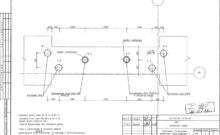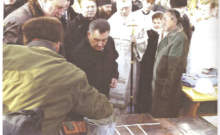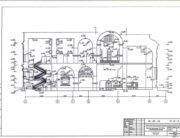Preliminary petrographic and microchemical studies of the Assumption Cathedral were carried out and made it possible to formulate the following conclusions.
In the original masonry of the Old Russian volume of the Assumption Cathedral, so-called lime-cement mortars were used. The technology of using these solutions arose under the influence of the Greek and Byzantine technologies, when ground ceramics, the so-called cemyanka, were applied to the lime binder as a filler. Construction technology using lime-cement mortars has existed for almost three hundred years, from the 10th to the 13th centuries in Kievan Rus. She was lost after the Tatar-Mongol invasion of 1240.
Lime-cement mortars solutions in various structures can differ among themselves in the quality of the raw material for heating in the manufacture of aggregate by the fractional composition of its fragments and the spacing of the components. Even among the solutions of the same structure, one can observe the difference between the solutions not only depending on the stages of the construction, but also on the purpose of the solutions (masonry or finishing).
For the monuments of Kievan Rus X beginning in the XI centuries, it is typical for loivated loess-like loam of the initial raw material for a special manufacturer of cement. From the end of the 11th century, instead of special aggregate, ground plinth was used, which was made by heating high-quality kaolin clay with the addition of sand. It was the Assumption Cathedral and became the first structure, where ground plinfa as a filler completely replaced a special impurity – cements. At the same time, the solutions kept all the physicomechanical properties inherent exclusively to lime-cement mortar.
All further reconstruction works of Ulensky Cathedral, which were carried out after the XIII century, were performed by lime-sand solutions using bricks. Despite the homogeneous composition of the substance, the solutions of almost every stage had their own specific properties, which allowed them to be divided into separate groups and approximate their dating according to chronology.
Fkhivtsyama GNSTC “Conrest” was determined according to the classification of masonry mortars eleven of their types.
The first type of lime-cement mortars are samples that are characterized by a light pink color, high density and strength. Solutions of the first type are characteristic for the foundation masonry masonry and for the masonry walls of the opus mixtum-type masonry (Old Russian volume). The starting raw material for the manufacture of aggregate was sandy aleuritic kaolin clay.
The second type includes samples of solutions of an intense pink color and high strength, in which the ratio of lime and cemyanka is 1-0.8 (1), and the filler consists of angular fragments, which are identical in composition to the plinths of the old Russian volume of charges. Solutions of the second type are found only in the laying and decoration of the walls of the old Russian volume. The composition and technology of the remains of the Church of St. John the Baptist were identical to the building materials of the old Russian volume of the cathedral.
The third type includes samples of solutions characterized by a rather intense pale-pink color, high strength and density. On the pale-pink background of the main mass of the binder, there are large multi-colored fragments of aggregate, the color of which varies from pink-ocher to dense-bulbs. In solutions of this type, the raw material for the manufacture of aggregate was silty sandy loam with a natural admixture of scales of micaceous materials. The ratio of lime and cemyanka is 1: 1.
Samples of solutions characterized by pink-red color, average strength and density are referred to the fourth type. The laying with the use of solutions of this type consists not of plinfs, but of red brick, whose surface is destructed due to weathering processes, indicates a low quality of the brick. The ratio of components is 1: 1 (1.2). These solutions are observed in the laying of the niche of the northern facade, which was walled up later than the original volume and in the remains of the laying at the northern entrance from the northern facade.
All other types of solutions – from the fifth to the eleventh – are lime-sand solutions. The fifth type includes samples of solutions characterized by the lime composition of the binder and sand composition of aggregate with admixture of fragments of ground lime-cement mortar removed from the destroyed masonry of the walls of the old Russian volume. The ratio of components (lime and aggregate) is 1: 1 (1.5), the presence of the bilacutric component is noted in the solutions. To the sixth type are assigned solutions from light gray to white color, with a lumpy macro-texture due to the presence of lime lumps, with medium strength and density. The ratio of lime and sand is 1: 1.5.
Solutions of the seventh type are characterized by a white color with a yellowish-cream tint, medium strength and density with a chalking effect, with an admixture of a bilocuturine component. The ratio of components is 1: 1 (1.5). Solutions of the seventh type are found in the laying of the outer southern wall, the construction of which dates from the year 1693.
The eighth type includes samples of solutions from light gray to white in color, with medium strength and density, lumpy macro-texture due to the presence of lumps of lime. The ratio of the components is 1: 1.2 (1.5). Solutions of the eighth type are observed in the masonry of the walls and foundations of the second stage of the restructuring of the walls of the Stefanivsky chapel and date back to the XVII – XVIII centuries.
Up to the ninth type are samples of lozchiniv, which are characterized by a light grayish-fawn color, homogeneous macrotextura, medium strength and density. The ratio of components is 1: 2.5. Solutions of the ninth type are observed in the outer masonry of the wall of the southern apse from the eastern facade and in the masonry of the buttress from the same side and date back to the period of the Ukrainian Baroque of the 18th century.
Solutions of the tenth type are gray with small white lime lumps. medium strength and density. Gray color gives impurities to the mixture in ground coal aggregates. The aggregate consists of a fairly well-sorted sand, the size of the debris which varies in the range of 0.8-0.1 m. Additive of ground coal is 15% aggregate. Solutions of the tenth type are observed in the laying of a pledged niche located in the interior to the right of the southern entrance of the old Russian volume of the cathedral and from the northern facade of the old Russian volume is in the interior of the Stefanivsky Chapel.
The eleventh type includes the solutions of the XIX century. They have a fawn-gray color and weak strength, the sivvidnoshenny components is 12.5 (3). sandy filler is poorly sorted, contains an admixture of clay minerals. Solutions of this type are characterized by laying underground communications.



















